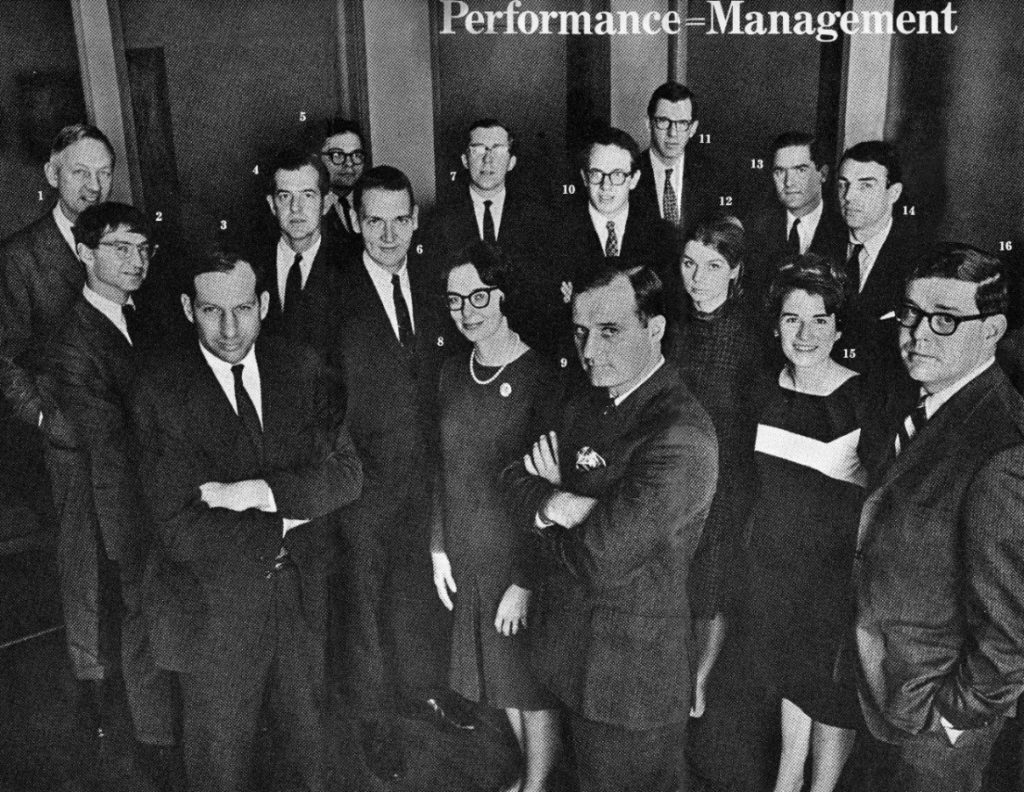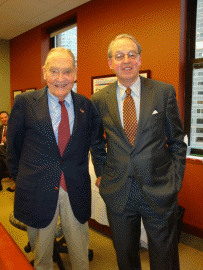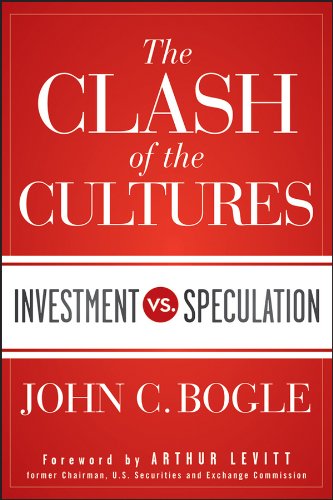Attempting to Combine Growth and Value Approach: A Merger that Failed and Spawned the Passive Movement
In 1968, the Philadelphia-based Wellington Management Company merged with the Boston-based Thorndike, Duran, Paine, and Lewis investment management firm (TDP&L). Joining TDP&L in 1968, this writer became part of the organization resulting from that ground-breaking merger.

Figure 1: In 1969, the Thorndike, Duran, Paine & Lewis (1 State Street, Boston) part of the Wellington merger. Jack Bogle is number 6 in the photo, Jim Joslin number 14, Bob Doran number 9, Nick Thorndike number 16.
Great Expectations
The combination of these two investment management firms attracted a great deal of attention in the financial services community. It was an early attempt to cobble an old line, value-oriented Philadelphia investment management approach with a growth-at-almost-any-price, performance-driven younger group of managers in Boston. The goal was to provide the new organization with a contemporary image as well as provide a smooth succession for Wellington's staff and clients. It turned out to be anything but an easy transition. Substituting growth stocks for traditional value-oriented selections in the Wellington Fund's balanced equity list in the early "Nifty Fifty" era of the 1970s proved to be a devastating market-timing mistake throughout 1973 and 1974.
The merger's outcome was unfortunate and difficult for all. When the break-up started in 1974, acrimonious media gleanings — most inaccurate as might be expected — sensationalized the proceedings. Jack Bogle has since written about this difficult period in The Clash of the Cultures1.
Jack Bogle Stops By

Jack Bogle and Jim Joslin at 2011 client meeting at 30 Federal Street.
Having worked with Jack Bogle during the early TFC-Wellington days, I maintained contact with him over the years, and followed the growth of his Vanguard offerings throughout. So, one day in 2011, knowing that in a few weeks Jack would be speaking at a national CFA Conference in Boston, I called and asked if he might have time after his presentation to stop by our offices. We provided him with a car and he joined us for an afternoon reception with a number of invited clients.2
Sometime following that gathering it struck me that a book-signing event featuring Jack and sponsored by our firm would be something others would find of interest. So, on a summer afternoon in 2012, 120 people arrived at the Brookline Country Club for Jack's talk, book signing (a free book for each attendee provided by TFC), and dinner.
Lunch at The Ritz
After the successful event in Brookline, we arranged for Jack to present The Clash of the Cultures to a Boston Society of Security Analysts (now, the CFA Society) luncheon at the Avery Street Ritz Carlton in May of 2013. It was a full-house turnout, and TFC provided all 250 attendees with a copy of the book. Jack's speech, which he had spent a great deal of time crafting for the occasion3, was a tour-de-force presentation of the history of the mutual fund business nationally and in Boston. For Jack it was a kind of Boston valedictory, and, selfishly for the firm, a chance to link TFC with an industry icon in a very favorable setting.

While introducing Jack to the CFA assembly at lunch that day in May, it struck me that it might be interesting to learn how this representative group of Boston's active portfolio managers invested their own personal financial resources. Just before turning the microphone over to Vanguard's founder, I asked for a show of hands from those in the audience who had personal Vanguard accounts. Virtually all 250 attendees raised their hands and confessed to some form of relationship with Vanguard. Almost all remained after lunch, standing in a long line with their free TFC-provided book for Jack to sign.
Stuck in a Loop: A Perennial Conflict of Interest?
The conflicted personal vs. institutional portfolio management dilemma indicated in that informal Ritz Carlton raised hands poll persists in Boston and globally to this day. As long as the broker-dealer and investment management businesses continue to flog the myth that "we have an information advantage and can therefore beat the market" — and the investing public continues to believe this assertion — the active management business will survive and continue to thrive.
TFC has always been aware of this active-passive conflict. In the firm's view, the best practical approach is a balanced core-passive-active combination strategy; one that uses periodic stock-bond mix portfolio rebalancing to a client's agreed-to objective norm, by which the investor captures the basic return of the asset class (or combination of asset classes) achieved in the markets over time. If that can be supplemented by a few actively managed strategies and talented managers that are carefully selected to enhance the chances of an improved risk-adjusted return, then the effort is worthwhile. Finding access to top talent is the key, and researching managers rather than individual stocks will uncover the expertise. Nevertheless, it remains a fundamental observation that reversion to the mean (less fees) is a statistical certainty and a critical precept to keep in mind when managing one's own and other peoples' money.
____________
1 John C. Bogle, John Wiley and Sons, Inc., 2012., pps 270-285
2 See also "Bogleheads meet the Head Bogle," Wall Street Journal, October 8, 2018, Section B and more recently, "The Father of the Index Fund Sees a Reckoning Ahead" WSJ December 1-2, 2018, P. B1, and "John Bogle, Lost a Job, Gained an Index Fund Fame," WSJ, December 10, 2018, P. R4.
3 For the full text of Jack Bogle's remarks at BSAS - May 17, 2013, see Big Money in Boston: The Commercialization of the "Mutual" Fund Industry.
Proceed to Helping Clients Gain the Confidence to Act Rationally in their Own Best Interest >
Sign The Guestbook
The author welcomes your feedback. Please sign the Guestbook to let us know of your visit to this website. There is a place to offer your suggestions, comments and/or questions.
